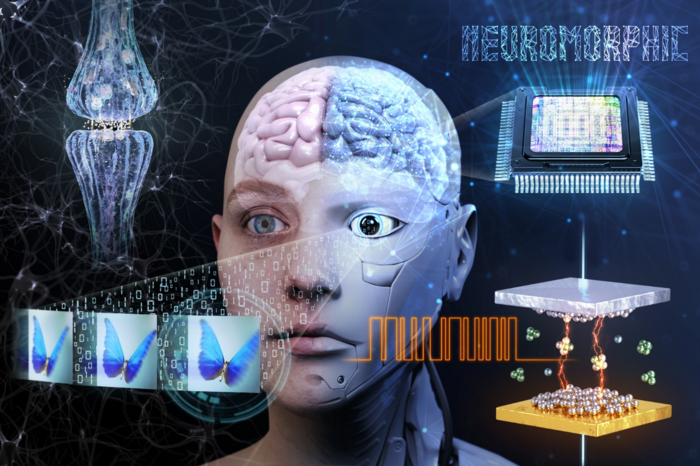Reviewed by Mila PereraSep 21 2022
The drawback of the conventional von Neumann computing method’s high-power consumption has been overcome by the development of neuromorphic computing systems, which imitate the human brain.
 Concept image of the article. Image Credit: Korea Institute of Science and Technology (KIST).
Concept image of the article. Image Credit: Korea Institute of Science and Technology (KIST).
The implementation of a semiconductor device that uses a brain information transmission technique requires a high-performance, analog artificial synapse device that can express different synaptic connection strengths. This technique takes advantage of signals sent when a neuron produces a spike signal.
When considering the traditional resistance-variable memory devices frequently employed as artificial synapses, the electric field builds as the filament grows with fluctuating resistance, generating a feedback phenomenon that leads to rapid filament growth.
As a result, it is challenging to incorporate a lot of plasticity and keep analog (gradual) resistance fluctuation depending on the filament type.
Dr. YeonJoo Jeong’s team at the Center for Neuromorphic Engineering at the Korea Institute of Science and Technology has overcome the long-standing problems with analog synaptic characteristics, plasticity, and information preservation in memristors and neuromorphic semiconductor devices.
He declared the creation of a synthetic synaptic semiconductor device capable of extremely dependable neuromorphic computing.
The performance of current neuromorphic semiconductor devices was hampered by modest synaptic plasticity, which the KIST research team addressed by adjusting the redox characteristics of active electrode ions.
Additionally, several transition metals were doped and employed in the synaptic device to alter the likelihood that active electrode ions will reduce. The high reduction probability of ions was shown to be a crucial factor in creating high-performance artificial synaptic devices.
The study team, therefore, added a titanium transition metal with a high ion reduction probability to an already-existing artificial synaptic device.
This preserves the analog properties of the synapse and the device plasticity at the biological brain’s synapse, which is around five times the difference between high and low resistances.
The team also created a high-performance neuromorphic semiconductor that is around 50 times more effective.
Compared to the current artificial synaptic device, information retention was enhanced up to 63 times due to the high alloy formation reaction involving the doped titanium transition metal. More accurate simulations of certain brain processes, such as long-term depression and potentiation, could also be made.
Utilizing the artificial synaptic device they had constructed, the team tried to implement an artificial neural network learning pattern for image recognition. As a consequence, compared to the current artificial synaptic device, the mistake rate was lowered by more than 60%.
In addition, the handwriting image pattern (MNIST) recognition accuracy increased by more than 69%. By improving the artificial synaptic device, the research team demonstrated the viability of a high-performance neuromorphic computing system.
This study drastically improved the synaptic range of motion and information preservation, which were the greatest technical barriers of existing synaptic mimics. In the developed artificial synapse device, the device’s analog operation area to express the synapse’s various connection strengths has been maximized, so the performance of brain simulation-based artificial intelligence computing will be improved.
Dr. YeonJoo Jeong, Senior Research Scientist, Center for Neuromorphic Engineering, Korea Institute of Science and Technology
Dr. Jeong added, “In the follow-up research, we will manufacture a neuromorphic semiconductor chip based on the developed artificial synapse device to realize a high-performance artificial intelligence system, thereby further enhancing competitiveness in the domestic system and artificial intelligence semiconductor field.”
Journal Reference
Kang, J., et al. (2022) Cluster-type analog memristor by engineering redox dynamics for high-performance neuromorphic computing. Nature Communications. doi:10.1038/s41467-022-31804-4.